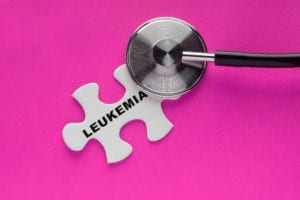Written by Angeline A. De Leon, Staff Writer. This study finds a significant correlation between chronic lymphocytic leukemia and residential levels of radon gas based on radon levels collected from counties in Iowa, North Dakota, Texas, and Wisconsin.
 Chronic Lymphocytic Leukemia (CLL) is a type of cancer affecting the blood and bone marrow. Each year, about 4,660 CLL-related deaths occur in the U.S., primarily in older adults in their 60’s and 70’s, with almost 19,000 new cases reported annually 1,2. Currently, the etiology of CLL is unclear. The disease has been found to be more common among Caucasians and males 3, but identifiable environmental risk factors, such as pesticide exposure, for example, remain inconsistent 4. Recent research has suggested a potential link between CLL and contact with ionizing radiation 5, which for the general public is most commonly found in the form of radon exposure in the home. Radon, a naturally occurring radioactive gas associated with rocks and soil, can seep through cracks in the foundation of a house, where accumulated levels have been shown to increase the risk of several types of cancer, including lung, stomach, and leukemia 6,7. In a 2017 study, researchers at the University of North Dakota conducted an investigation examining the potential correlation between residential levels of radon (RR) and the incidence rate of CLL at the county level.
Chronic Lymphocytic Leukemia (CLL) is a type of cancer affecting the blood and bone marrow. Each year, about 4,660 CLL-related deaths occur in the U.S., primarily in older adults in their 60’s and 70’s, with almost 19,000 new cases reported annually 1,2. Currently, the etiology of CLL is unclear. The disease has been found to be more common among Caucasians and males 3, but identifiable environmental risk factors, such as pesticide exposure, for example, remain inconsistent 4. Recent research has suggested a potential link between CLL and contact with ionizing radiation 5, which for the general public is most commonly found in the form of radon exposure in the home. Radon, a naturally occurring radioactive gas associated with rocks and soil, can seep through cracks in the foundation of a house, where accumulated levels have been shown to increase the risk of several types of cancer, including lung, stomach, and leukemia 6,7. In a 2017 study, researchers at the University of North Dakota conducted an investigation examining the potential correlation between residential levels of radon (RR) and the incidence rate of CLL at the county level.
RR levels and CLL rates were investigated among U.S. states with publicly available data compiled by the USA Environmental Protection Agency (EPA). CLL incidence rates per county were age-adjusted to the 2000 U.S. standard population and computed based on a 15-year time period (1999-2013).
Data on county-level CLL incidence rates and radon levels were collected from a total of 478 counties (from Iowa, North Dakota, Texas, and Wisconsin, the first two states reported as having the highest RR levels in the country). In total, 92%, 86%, 25%, and 4% of the counties in each respective state demonstrated a mean residential level of radon exceeding 4 pCi/l, the action level set by the EPA requiring safety measures to be taken. After adjusting for ultraviolet radiation (a possible risk factor for CLL), a significant positive correlation was reported between county rates for CLL and RR among males and females, both together and separately (p < 0.0001 for all).
Overall results confirm a significant, positive, linear association between CLL rates and RR at the county level. This epidemiologic investigation supports previous suggestions that CLL may be produced by radioactivity and suggests that radon exposure may play a role in its etiology. Follow-up studies looking at individual differences in CLL risk among residential citizens in a given region would be highly valuable.
Source: Oancea SC, Rundquist BC, Simon I, et al. County level incidence rates of chronic lymphocytic leukemia are associated with residential radon levels. Future Oncology. 2017; 13(21): 1873-1881.
© 2017 S. Cristina Oancea for Gary G. Schwartz. Attribution-Non Commercial-No Derivatives 4.0 Unported License. http://creativecommons.org/licenses/by-nc-nd/4.0/
Click here to read the full text study.
Posted November 13, 2017.
References:
- Siegel RL, Miller KD, Jemal A. Cancer statistics, 2016. CA: a cancer journal for clinicians. 2016;66(1):7-30.
- Institute NC. Cancer Stat Facts: Chronic Lymphocytic Leukemia (CLL). 2017; Fact sheet on chronic Lymphocytic Leukemia. Available at: https://seer.cancer.gov/statfacts/html/clyl.html. Accessed November 12, 2017, 2017.
- Shanafelt TD, Rabe KG, Kay NE, et al. Age at diagnosis and the utility of prognostic testing in patients with chronic lymphocytic leukemia. Cancer. 2010;116(20):4777-4787.
- Cocco P, Brennan P, Ibba A, et al. Plasma polychlorobiphenyl and organochlorine pesticide level and risk of major lymphoma subtypes. Occupational and environmental medicine. 2007.
- Řeřicha V, Kulich M, Řeřicha R, Shore DL, Sandler DP. Incidence of leukemia, lymphoma, and multiple myeloma in Czech uranium miners: a case–cohort study. Environmental health perspectives. 2006;114(6):818.
- Barbosa-Lorenzo R, Barros-Dios JM, Raíces AM, Cerdeira CS, Ruano-Ravina A. Residential radon and cancers other than lung cancer: a cohort study in Galicia, a Spanish radon-prone area. European journal of epidemiology. 2016;31(4):437.
- Turner MC, Krewski D, Chen Y, Pope III CA, Gapstur SM, Thun MJ. Radon and nonrespiratory mortality in the American Cancer Society cohort. American journal of epidemiology. 2012;176(9):808-814.

